Playing with History
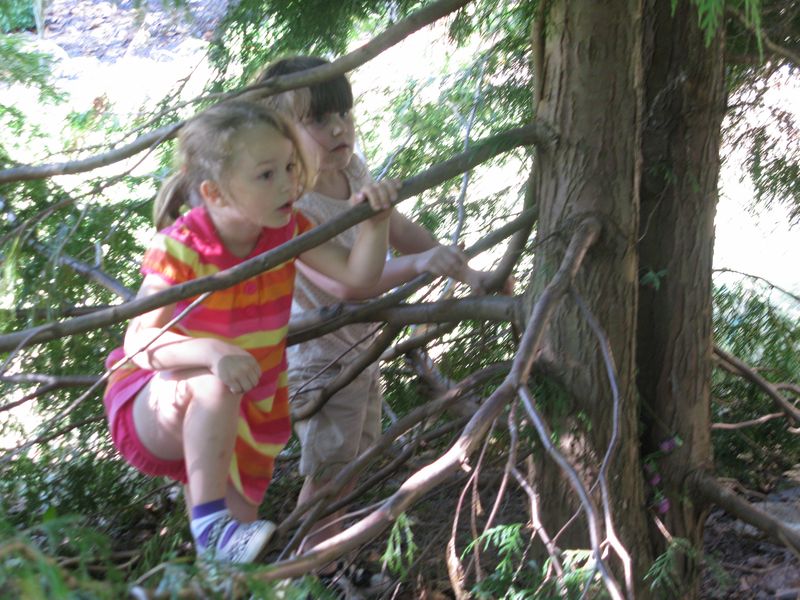
It
is a widely held belief that play is the work of young children. I think this
statement has evolved because, as a society, we intend to give importance to the creative flow and joyful activity
that children so naturally engage in as they move through the earliest stages
of life.
Play
is so indispensable to human development that it has even been recognized by
the United Nations as a basic human need and right for every child.
Here
is a description from Richard Lewis’ book, Living By Wonder, that
might bring back some memories:
It was one of those warm summer evenings. I was on my way home when, just at the
entrance of the park where I had been sitting, I saw three small children
chasing fireflies. It was getting
late, but I lingered for a moment to watch them. The children were completely involved with what they were
doing: the sweep of their arms as
they tried to close their hands on a firefly’s humming light; their bodies
arching forward when what escaped them suddenly appeared a few feet away; their
excited whispers sifting quietly around us. Then quite unexpectedly, one of the
children, sure that she had caught a firefly, came running to her father
nearby– and opening her hand, proudly showed him what was inside. Both she and
her father looked, but there was nothing except her bare hand. No matter, off
she quickly went to her friends, dizzying themselves in their leaps and
hoverings, trying to find out what it must feel like to have particles of light
so close to them.
Think
back for a moment to your own childhood.
Remember the thrill of bringing your body up to it’s top speed, running
down the sidewalk, rolling down a hill, the anticipation and challenge of those
three little phrases: On your
mark, get set… GO!
Or
maybe there was a quiet place– a fort of pillows in your living room, the
highest branch of the tallest tree you could climb, the fleeting moment of
wiggling creatures in their world under the rock you overturn.
Remember your
favorite doll, your imaginary friends, the worlds you created with the magic
words: How ‘bout you be the… and
I’ll be the… and let’s pretend.
You could be anything you wanted to be, wondered about, worried about,
or wanted to try.
At Portland Children's Museum, we think these
words embody the spirit and experience of play:
joy, inquiry,
inspiration, listening and relationships, divergent thinking, imagination,
multiple forms of human expression, opportunities to find your medium, a sense
of belonging
Are there words you would add to the list?
At the Portland
Children’s Museum, we’ve been asking ourselves:
What benefits come
of childhoods steeped in healthy amounts of play?
And at Opal
School, we’ve been asking:
How can we put the power of play to work in the
service of the learning we want children to do?
The importance of
play is a pretty hot topic these days. Neuroscientists and other specialists
in human growth and development are finding important links between play, brain
development, and learning.
The American
Academy of Pediatrics is clear about the strong relationship between play and
healthy child development. We know that play evolved in our species so that we
could encounter novel things in the environment and figure out how they work.
We know there is a strong correlation between play behavior and cognitive
function: the fewer instinctive behaviors a species has, the more play
behaviors it has. Play literally sculpts the human brain: we know that what
“fires together, wires together”. Play behaviors invite rich experience and
robust thinking. And we know that children can learn a skill through direct
instruction or through play, but those who learn through play have higher
levels of engagement and the learning lasts longer. Children learn best when
skills are learned in meaningful contexts. Play gives learning meaning.
Because we believe
this research to be the best to which our culture currently has access, at Opal
School we’ve been wondering:
How might we use
the power of play to strengthen and deepen learning in traditional academic
areas?
In spite of all we
know about the importance of play for developing minds, we notice this widening
gap in our society between what we accept as places for play, and what we think
of as environments for learning. In
his book Play, Stuart Brown writes about current education models:
The neuroscience of
play has shown that this is the wrong approach, especially considering that
students today will face work that requires much more initiative and creativity
than the rote work this educational approach was designed to prepare them for. In a sense, they are being prepared for twentieth-century work, assembly-line
work, in which workers don’t have to be creative or smart– they just have to
be able to put their assigned bolt in the assigned hole.
If play is the
engine of learning, if play sculpts the brain, then how can we capitalize on
the power of play to make learning even more real and meaningful—in schools, in
museums where children are an intended audience, and in parent/child
interactions?
Supporting play
brings great joy in the moments we spend with children now, and can help us be
certain that we are offering them the kinds of experiences that are stuff of
happy childhoods. But we must also
be asking ourselves about the work we are doing in the service of preparing
citizens who can participate fully in our democracy as creative problem solvers
and strong, critical thinkers. How might play and playful inquiry help with
that?
We seem to stumble
when it comes to figuring out how to participate and support this genius of
childhood as adults who feel responsible for somehow “teaching” children a
bucket of information we believe it is vitally important for them to know—the
facts of early American history, for instance.
Susan Harris MacKay tells a story about playful inquiry in the classroom:
I’m going to tell you about an experience I had with my class of 9 –
11 year olds at Opal School as we approached the Oregon 5th Grade
Standards for teaching American History. This will be just a small slice of a
project that lasted over 6 months and intersected every aspect of our lives in
the classroom.
We began, early in
the year, with a homework project intended to help us build a collaborative
timeline of the decades of the American story beginning 1770 – just before the
time of Revolution and Constitution – where the Standards dictate we focus our
attention.
In order to begin, I wrote the years on small pieces of paper and asked each child to pull one from
a basket – playfully beginning 6 weeks of research to be conducted at home and
shared at school. Each week they were asked to research different aspects of
their decade – elections, census questions, art and music, big questions and
conflicts of the day.
The intention was
for this to be a foundation for work we would do together. It was hard for me
to imagine that such a vast scope of the American History timeline would
provide much meaning or engagement for 10-year-olds, just a decade old
themselves. I thought that this timeline would provide a backdrop and context
for other work as we returned to the early part of the timeline, as dictated by
the Standards.
But as kids
learned more and brought more information about their decades to each other,
their interest grew.
Between the
independent work they owned and
the sharing that spiraled because of it, a playful exchange developed between students – connecting what they’d found out and finding a sense of
belonging because they each held such an important piece of the whole.
Their research
involved play with the arts and materials, and, of course, they played with
each other—so I shouldn’t have been surprised, I guess, when I started to hear
their ideas about moving forward with this project come together in a way I
hadn’t imagined.
In his book about
play, Stuart Brown writes that the opposite of play isn’t work—it’s depression.
To be sure, these kids were working hard and the more they worked, and the more
they shared, the more curious and invested they became and the more ideas they
had!
First they
proposed the idea to write historical fiction that would feature a 10-year-old
character who lived during the decade they had researched. (That is a story in itself and one I won't focus on in this article… but suffice it to say, they amazed me!)
Then they
wanted to become the character they’d worked so hard to create.
Then they
wanted to meet each other in character.
Every idea came through them with delight, excitement, and anticipation of possibility. This was their
play – and I chose to listen their desires to move forward. My agenda followed
theirs. And for that reason, this project can never be repeated.
Real
play … emerges from the imaginative force within. …with a pinch of pleasure, it
integrates our deep physiological, emotional, and cognitive capacities. And
quite without knowing it, we grow.
Of course, if they
wanted to meet in character, they would need a time machine, which was a simple
matter of imagination. The first meetings of characters were all about
play—playing together in character, meeting each other, finding out what would
happen, acting out possibilities, and especially, getting their giggles out.
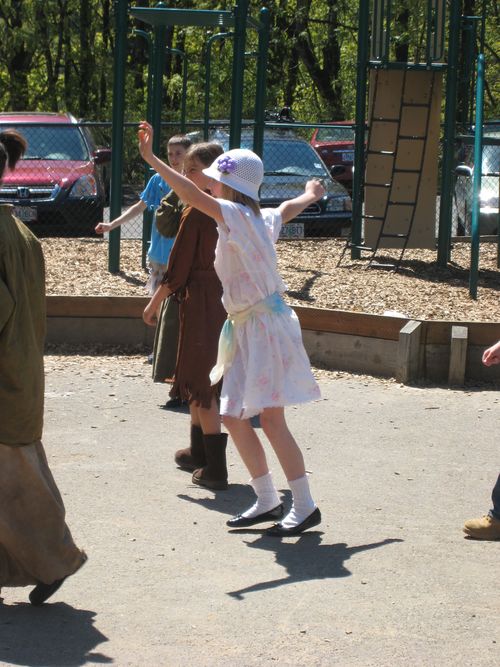
The more we
playful we are, the more we want to engage and think and share and they each
brought so much to each other from their research and the perspective they’d
developed. They were fully living in the skin of the decade they’d imagined
through real research.
Here are a couple
of reflections written by students after that first trip through time:
It was so cool seeing other people in different clothes or
how some kids tried to act. Cash was the most funniest character. He was a
hippie– and he was a good hippie.
Jared, age 10
Yesterday, when we climbed into the body of our character
was probably the most fun I have had this whole school year. The way that
everybody was able to “leave themselves” at the year 2009 just completely
worked. Everybody has worked so hard to learn everything they possibly can
about their decade and that really showed and paid off. I felt that it went
really well and was really fun when we went outside because a lot of the
characters had never even heard of a playground!Sophie, age 10
My
agenda, and the agenda of the state of Oregon still mattered. Kids still needed
to learn the content the standards required. The engagement of the children in
the project left them ripe for direct instruction. Imagine a group of perfectly normal 4th
and 5th graders hanging on every word of a lecture about the Bill of Rights! For an hour! But they needed this information in order to breathe ever more life into their imagined worlds. Their brains were primed to connect, and
so they absorbed it willingly and put it to use.
Now that they had
a time machine anyway, we wondered: What if these characters could convene and attend
the Constitutional Convention? What would these children of the future have to
share with the Framers of our government?
I want to share a
few snippets of the speeches they wrote to share their experiences and
perspectives at that Constitutional Convention. Consider the
rigorous task put before them – the research, the writing, the development of a
character’s voice through which to deliver an imagined perspective. Here is a
sampling of the depth and range of this excellent work:
Isaac 1770:
I have grown up in a nation that has been recently created for the purposes of
liberty, justice, freedom and independence, also known as the States of America.
Everybody after my time has been talking of a constitution of these states,
that they say shall be united, but how could the states be united?
Here is Julianna's speech in it's entirety:
Download JuliannaSpeech6.17.09.mov (14663.0K) (Use your browser's back button to return to this article after viewing the video.)
Max 1820:
If everyone was equal no one would be scared. The angry wild fire in a white
man’s heart would be put out by cool waves of water. The shards of hatred
disgust, fear, lies, and stories would break. White men would finally be able
to see again and everyone would be safe.
Here is Josephine's speech in it's entirety:
Download JosephinedecadeSpeech6.17.09.mov (8947.3K) (Use your browser's back button to return to this article after viewing the video.)
Jaden 1910:
The government has looked at the Constitution sideways. They believe that
children, women and blacks are simply property. Like a chair in your house,
nothing more. I have traveled on a terrible boat ride thinking I was going to
the land of hope but now this land is not the land of hope. The Constitution
lied. It did not fulfill its duties. It did not give a better life or liberty
or justice for all. So now it’s time for the people to act for the common good.
Benjamin 1970:
I stand here knowing I can make a difference in this world. Discrimination is
the first thing I would change. The Constitution says “every man is equal”, but
my father is a man, and he can not drink from a clean fountain. He cannot sit
on the front row of the bleachers and watch me wrestle.
Emmerson 1990:
Education is the key to peace, for peace is not just no war, it is no violent
acts for peace. Because every time a bullet flies, a young mind is broken apart
by fear, by fear of losing something –something he can grasp to hold onto in
the dark. If you look at any time in history, any place in the world, you can
see families being torn into the rainy tornado of war. This tornado has torn
apart my family and many others. To feel empathy for anyone you must look at
two sides of things even though one side is hidden to you. To decide one side
is not important is a gigantic mistake.
Is it possible
that, ironically, the more we play, the more rigorous the curriculum can be?
The higher expectations for thinking and problem solving and innovation we can
have? Is it possible that play rasies our expectations for those important 21st century skills?
Ultimately, the
biggest task I put before them was to think together with the constitutional
writers (played by me, a parent, and a co-teacher) about language that could be
included that would have made fairness and liberty and equality more clearly
required for all citizens.
Click to this post to see snippets of the "Convention" in action.
In their speeches,
many of them had appealed for the use of the heart in law-making and law
interpreting. I told them about the contemporary discussion about President
Obama’s Supreme Court nomination of Sonia Sotomayor and the concern of some
that she spoke openly of the need for empathy in law. I asked them what they
thought about that.
John: It shouldn’t all be about what you feel. It has to be
about what agreements we’ve made in this country—not, “Well, I feel this person
who did something bad is sad, so I’m going to help him, not this guy who really
has safety because the law says." It is about what laws we have in America.
Period.William: If the laws are correct and your heart is correct, your
heart and the laws should fit together. You should be able to act with your
mind according to your heart. You should be able to do both. Either there’s
something wrong with the law, or your heart is in the wrong place, and you have
to fix one of them.Jim: There is no wrong decision! There’s no such thing as a
wrong opinion!Lillian: There is such a thing as a wrong decision. But there’s no
such thing as a wrong opinion.Many children
agree.Lillian: Anybody can have their own opinion. Like I bet my opinion
is very different from anybody else’s here. It might be similar but it’s
different still. But if I make a decision to do something to someone, it could
be wrong.Anna: You don’t want to use your heart so much that you are just
saying “I don’t like this guy so I’m not going to help him.” That’s using your
heart in the wrong way. It would be the wrong decision but you could have that
opinion. Your opinions can be different than your decisions, and they kind of
should be.Margaret: I think this is really just another reason why we should
learn history. Because if we make a decision that in history lead to horrible
things that we had to fight over, then we should think about history—especially
if you’re in the government, you really need to know about history so you know
not to make a wrong choice.
They continued talking, and at another point, I asked them:
What is the role of empathy in making laws?
Margaret: I think the role of empathy is to really feel out what
other people would feel before you make a decision that affects them. Like FDR was really good at feeling out
how poor people felt during the depression. He made laws according to how other
people felt other than him.The United States
is really a big web. If a leader does something that affects one group of
people, the web can break, because they’re part of our community, too. If that
person doesn’t think about other people, everyone suffers in the smallest of
ways.Jim: If you think all you should use is empathy for your
decisions, maybe you think that, but you cant’ quite do that when you have
opinions. If your opinion is that using empathy is the only way to make
choices, you can’t quite use your own opinions to make decisions because there
are two opinions out there.Teacher: I’m wondering if it’s when you don’t make decisions with
empathy that you end up taking sides?Margaret: Yeah, you can’t really make a good decision without
empathy. It requires you to think of everyone’s perspective.John: It’s like there are two doors and they both lead to hallways
and one has treasure in it and that’s good for you and only you. The other hallway has people who are
stuck in it and they can’t get out but if you let them out they’ll be
free. But you can only open one
door. So the empathic decision would be to find a 3rd door.
I was stunned.
To find a third door is such an elegant idea. It occurred to me that that was
perhaps what this whole project was about. Perhaps what playful inquiry is all
about: finding new possibilities we simply haven’t yet imagined, but that exist
just as surely as another door to open and inviting us through.
In the end,
this is the language they decided to include in their revisions to the
constitution:
When there are sides that are not in agreement, make a
compromise that will make all sides happy enough to avoid conflict.
The simplicity of their final language is
profound. In the end, they related much of their thinking to what has worked
for them as they’ve developed their own classroom community all year
long—finding parallels between their public and private lives that will help
them navigate their experiences as citizens in this society for the rest of
their days.
Some might wonder if it isn’t a little sad
to have children learn about these stories of struggle and conflict and
violence that we have in our history as a country.
These children were serious and contemplative,
but not sad. They were playing and working and so they were not depressed. This work was heavy and important – and
they knew without a doubt that it had everything to do with them.
Children are caught in this incredibly
tricky place. Their drive to learn and their drive to belong are equally
strong. In their work with adults, they so often find the need to compromise
one or the other of these drives. Too often, adults distrust the drive to learn, and threaten
children’s need to belong by taking away the right to play and alienating,
shaming, or punishing those who don’t perform.
What might happen for all of us if we
unleashed the power of children’s minds by creating learning environments that
supported playful inquiry?
These reflections of the work the children
did together offer a glimpse of possibilities:
The children of the future
need stories to wonder and learn so that they can be curious. And if you’re
curious, you don’t make stereotypes and when you don’t make stereotypes, you
don’t discriminate against other people. Which is good. Because discrimination
doesn’t make us a happy community.Chloe, age 11
When people look at the things I have created to tell
stories, I want them to think about who they could tell those stories to. And I
want these stories to sing in their hearts.Olive, age 11
The last line
of Stuart Brown’s book echoes these ideas:
When
enough people raise play to the status it deserves in our lives, we will find
the world a better place.
But I like the
way this Opal 3 student said it even better:
The children of the future should know this history because
if they don’t, how will they know how to hope? They need to know that you need
to have belief and strength to be able to make the world a better place.Max,
age 11


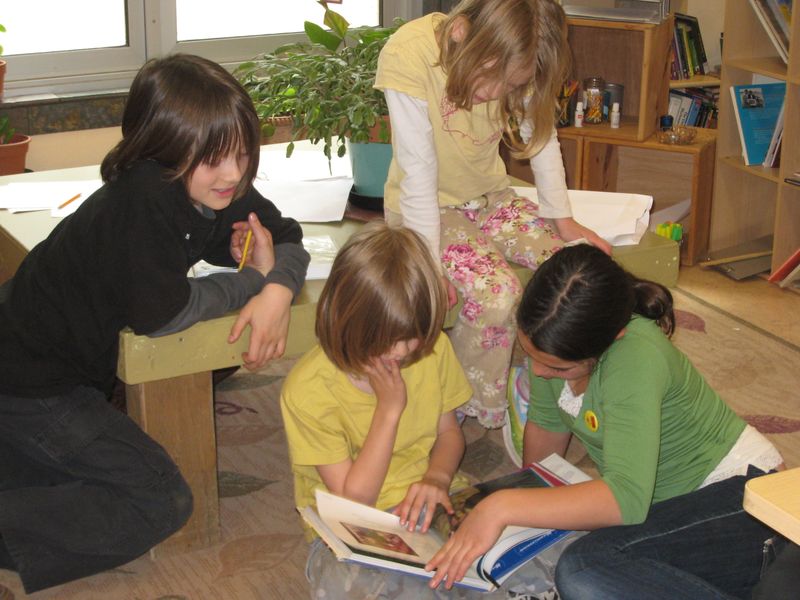
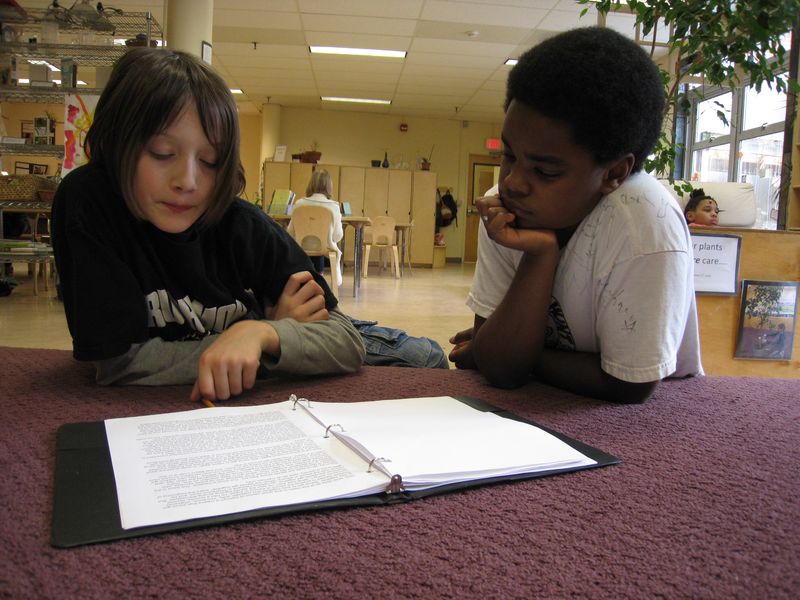
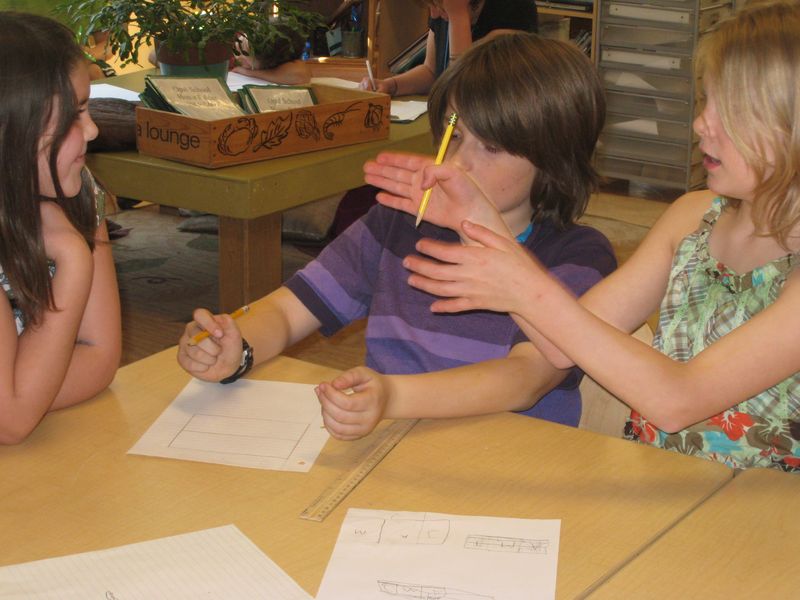
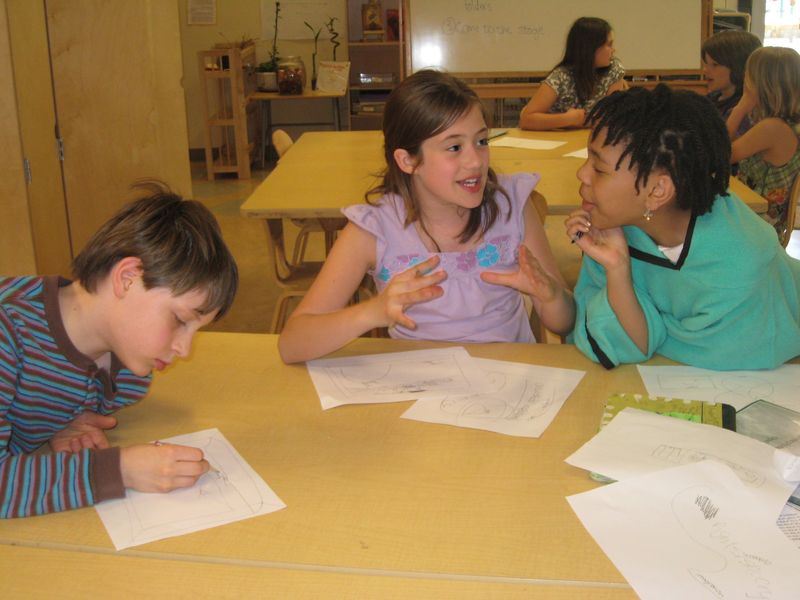
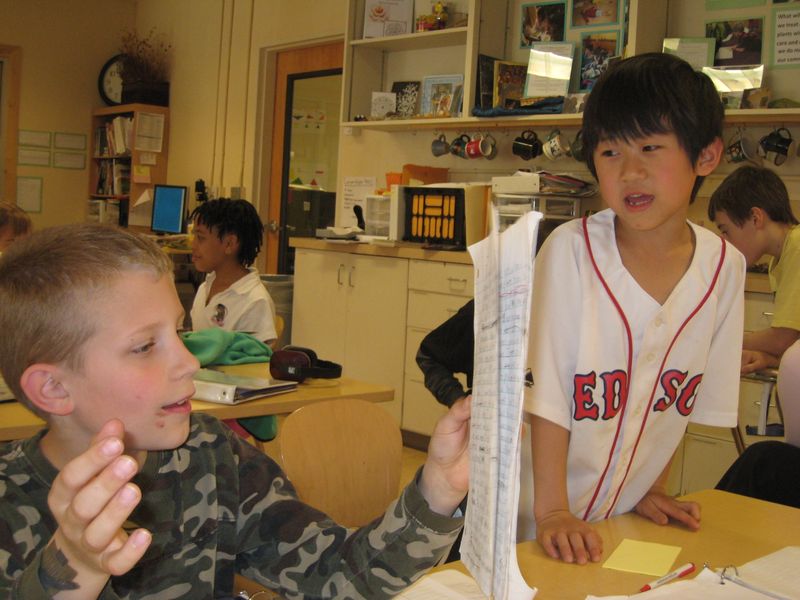
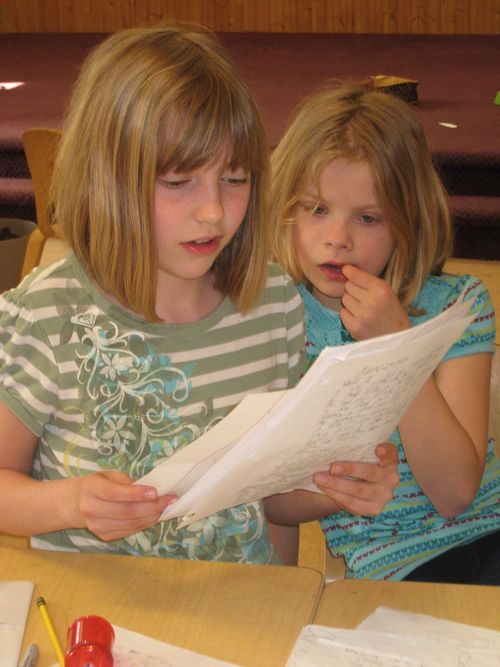
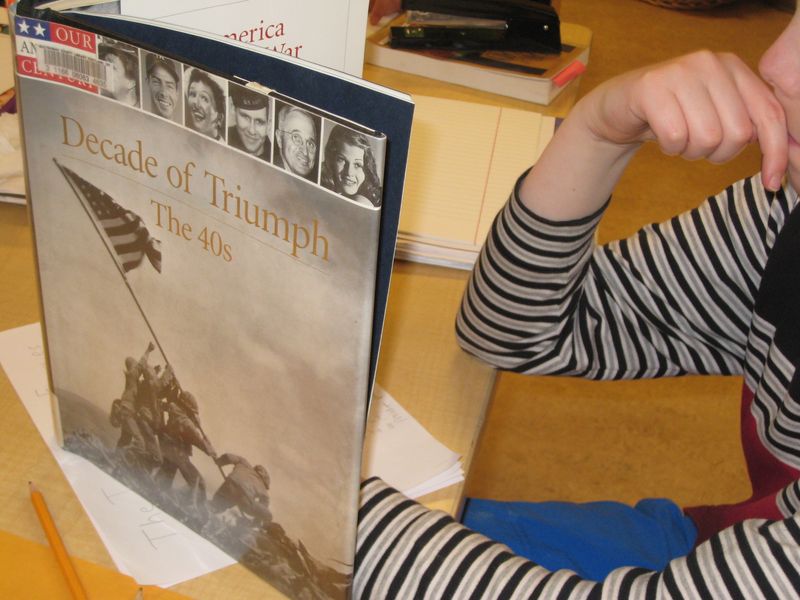
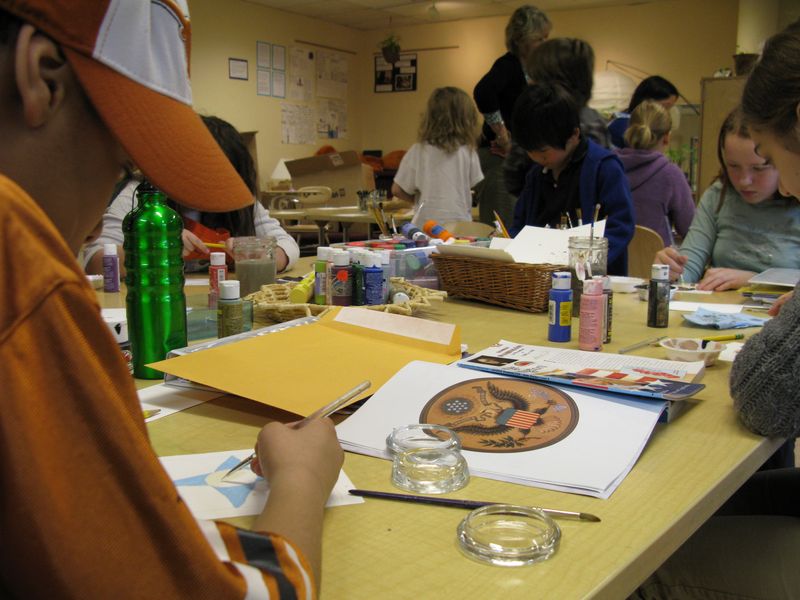
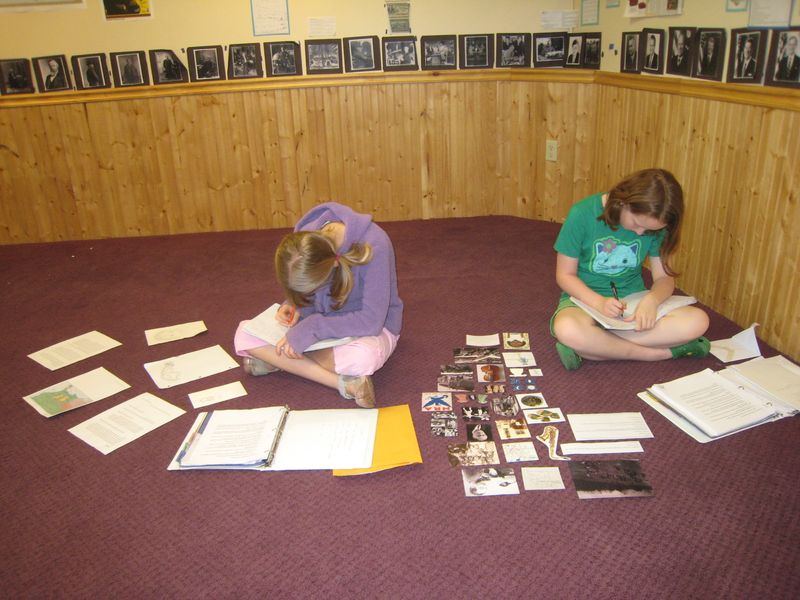
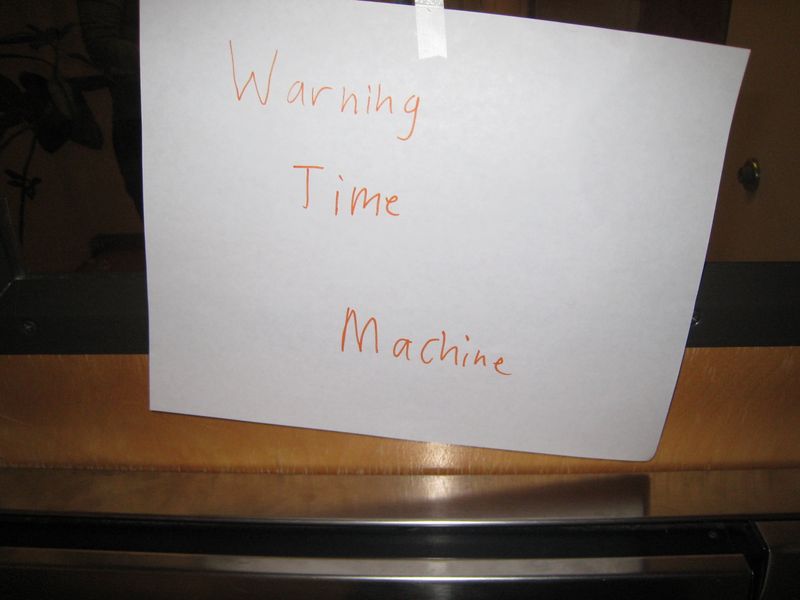
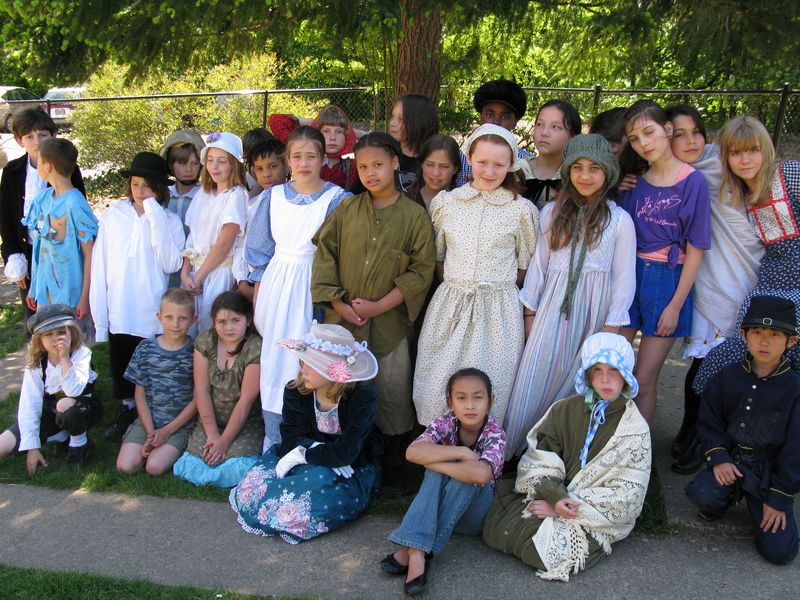
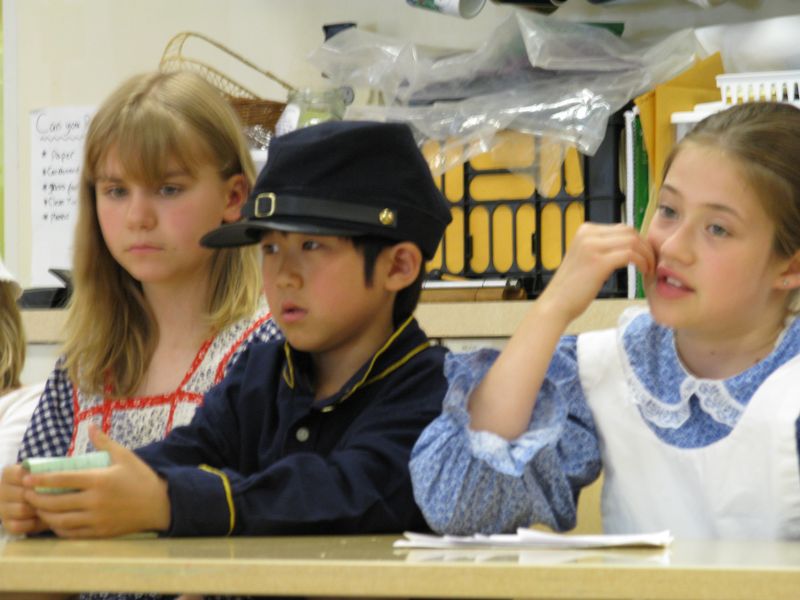

As the current 5th grade teacher at Opal School, I am so inspired to read this post in its entirety, to see the possibility of a whole project coming out of time carved out for children to play. When I go back to the top of this post where you asked what words I would add to the spirit and experience of play, I want to add: the feeling of getting lost in time and space while you play. What a great connection to a study of history! When a teacher learns to trust that play will lead to rich experiences, nurtures a community who knows how to play together and take risks together, and is willing to play herself… wow! They will ask for resources that will cover the state standards and then some, and, the learning will stay with them (and you!) forever.
When you asked if there are words that embody the spirit and experience of play you would add to the list, I would add the word natural. Much like learning is a natural instinct I also feel that play is natural. You don’t force play in a child; it is a natural part of childhood. Children innately what to play with things and explore! Children learn so much through play and the experiences that play unfolds. I feel that play should be incorporated into all grades of learning. Play opens up the window for you to discover the best way to learn something. What children learn through play cannot be taught in a text book, it’s too rich of an experience. Just look at this example of the playing with history and how rich of a learning experience those children had. It’s so refreshing to see a teacher let 5th graders play, and to see 5th graders get excited about play.
-CMSD
The words I would add to the list are challenge, focused and feeling fully alive – all of our senses are engaged and we are living fully in each moment.
Empowering our students to use play as a way to connect with any learning is very powerful. Play so intimately connect us to our culture, emotions, sense of identity, and understanding of others.
I think the emotional connections the Opal students made to their historical characters is what made this learning so powerful for them. Empathy is a vital attitude that all problem-solvers will need if we hope to solve any of the global problems faced by our world.
Kudos to the Opal teachers for supporting the natural tendencies of children to develop relationships – even fictional ones – to lead this inquiry.
As somebody who was able to participate in this project as both a parent and a “critical friend,” I appreciate revisiting it through these two entries. This outing negotiated some interesting tensions through playful historical inquiry and an emphasis on empathy. It’s the kind of investigation I wish more teachers of older children would explore!